4 Chapter 4: Foundational Philosophies of Education
Foundational Philosophies of Education
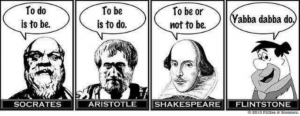
A philosophy is often defined as the foundation upon which knowledge is based. However, when you break apart the actual word, a much different meaning emerges. Derived from the Greek “philos,” which means love, and “sophos,” which means wisdom, the actual meaning of the word philosophy is love of wisdom (Johnson et. al., 2011).
In this chapter, we will explore how traditional philosophies have evolved over time by briefly looking at three key branches of philosophy. Then, the schools of philosophy and their influence on education will be presented. Finally, you will hear from educators in the field and see how they put their “philosophies” of education into practice.
Section I: Schools of Philosophy
4.1 Essential Questions
At the end of this section, the following essential questions will be answered:
- What are the four main schools of philosophy?
- Who were the key philosophers within each school of philosophy?
- What are the key implications of each school of philosophy on education today?
There are four broad schools of thought that reflect the key philosophies of education that we know today. These schools of thought are: Idealism, Realism, Pragmatism, and Existentialism. It is important to note that idealism and realism, otherwise known as general or world philosophies, have their roots in the work of the ancient Greek philosophers: Plato and Aristotle. Whereas pragmatism and existentialism are much more contemporary schools of thought.
It is important to study each school of thought because they shape the way we approach education today. Specifically, each school of thought directly impacts how curriculum is developed, implemented, and assessed.
Idealism
Idealism is a school of philosophy that emphasizes that “ideas or concepts are the essence of all that is worth knowing” (Johnson et. al., 2011, p. 87). In other words, the only true reality is that of ideas. Based on the writings of Plato, this school of philosophy encourages conscious reasoning in the mind. Furthermore, idealists look for, and value, universal or absolute truths and ideas. Consequently, idealists believe that ideas should remain constant throughout the centuries.
Key Philosophers
Plato (ca. 427 – ca. 347 BCE):
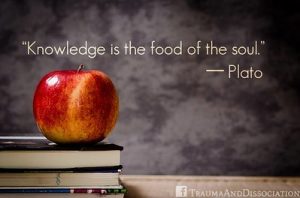 Plato believed
that truth was the central reality. However, Plato did not believe that people created knowledge, instead they “discovered it” (Johnson et. al., 2011). In his book, The Republic, Plato talked about two worlds: the spiritual or mental world and the world of appearance. Reacting against what he perceived as too much of a fo- cus on the physical and sensory world, Plato called for education to “develop in the body and the soul of the pupil all the beauty and all the perfection he is capable of.” (Cohen, 1999, p. 1). In addition, to understand truth, Plato believed you must first understand knowledge.
Plato believed
that truth was the central reality. However, Plato did not believe that people created knowledge, instead they “discovered it” (Johnson et. al., 2011). In his book, The Republic, Plato talked about two worlds: the spiritual or mental world and the world of appearance. Reacting against what he perceived as too much of a fo- cus on the physical and sensory world, Plato called for education to “develop in the body and the soul of the pupil all the beauty and all the perfection he is capable of.” (Cohen, 1999, p. 1). In addition, to understand truth, Plato believed you must first understand knowledge.
4.2 A Closer Look
- How does the Allegory of the Cave give us insight into Plato’s conception of reality?
- What are some other examples of “cave-like” thinking?
- Do you agree with Plato’s premise? Why or why not?
Socrates (ca. 470 – ca. 399 BCE):
Socrates’ work is only known through the works of Plato. Plato
observed Socrates questioning a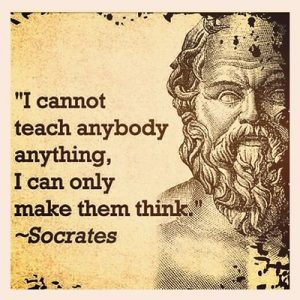 slave boy to help him understand
what he knew about a specific
concept. This questioning technique became known as the
Socratic Method and was presented in chapter one. When applied in classrooms, the Socratic method actively
engages students in the learning process, improves understanding, and promotes higher-order thinking.
slave boy to help him understand
what he knew about a specific
concept. This questioning technique became known as the
Socratic Method and was presented in chapter one. When applied in classrooms, the Socratic method actively
engages students in the learning process, improves understanding, and promotes higher-order thinking.
4.3 A Closer Look
- In what ways does the Socratic Method actively engage students in the learning process?
- Do you think this method improves students understanding?
- How does this method promote higher-order thinking?
- Elementary Example: Socratic Seminar Strategies for the Second Grade Classroom [YouTube]
- Secondary Example: Scaffolding Discussion Skills with a Socratic Circle [YouTube]
Kant (1724 – 1804):
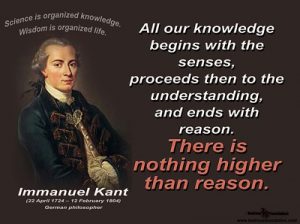 Immanuel Kant was a German philosopher who believed in “freedom, the immortality of the soul, and the existence of God” (Johnson et. al., 2011, p. 88). He added valuable information about the important role of reason and its’ contributions to knowledge. According to his research, it is only through reason that we gain knowledge of and understand the world in which we live.
Immanuel Kant was a German philosopher who believed in “freedom, the immortality of the soul, and the existence of God” (Johnson et. al., 2011, p. 88). He added valuable information about the important role of reason and its’ contributions to knowledge. According to his research, it is only through reason that we gain knowledge of and understand the world in which we live.
Educational Implications of Idealism
When translated to the classroom, teachers with an Idealist school of though would emphasize being role models of these absolute truths, ideas, and values. Curriculum would focus on broad ideas, particularly those contained in great works of literature and/or scriptures. Teaching methods used within idealism include: lecture, discussion, and Socratic dialogue. Essential to these teaching methods is posing questions that generate thoughts and spark connections.
Paul (n/d) suggests the following six types of Socratic questions:
- Questions for clarification
- How does this relate to our discussion?
- Questions that probe assumptions
- What could we assume instead?
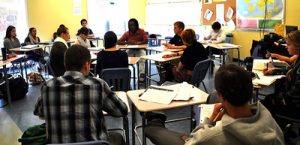
- What could we assume instead?
- Questions that probe reasons and evidence
- What would be an example?
- Questions about viewpoints and perspectives
- What is another way to look at it?
- Questions that probe implications and consequences
- What are the consequences of that assumption?
- Questions about the question
- What was the point of this question?
Realism
Realism is a school of philosophy with origins in the work of Aristotle. This philosophy emphasizes that “reality, knowledge, and value exist independent of the human mind” (Johnson, 2011, p. 89). Realists argue for the use of the senses and scientific investigation in order to discover truth. The application of the scientific method also allows individuals to classify things into different groups based on their essential differences.
Key Philosophers
Aristotle (384 – 322 BCE):
Aristotle is known as the father of realism and the Scientific Method. His pragmatic approach to under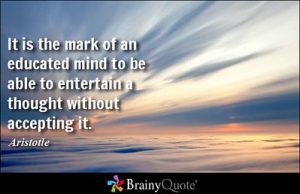 standing an object, by understanding is form, is an example of how he investigated matter. To understand this concept, consider the following example: A plant can exist without being physically present, but it still shares properties with all other plants (form). Aristotle also believed that everything had a purpose or function. For example, a fishes purpose is to swim. A birds purpose is to fly. A humans purpose is to think. If we are not thinking, or thinking unintelligently, we are going against our purpose. Finally, Aristotle was the “first to teach logic as a discipline in order to be able to reason about physical events and aspects” (Cohen, 1999, p. 1).
standing an object, by understanding is form, is an example of how he investigated matter. To understand this concept, consider the following example: A plant can exist without being physically present, but it still shares properties with all other plants (form). Aristotle also believed that everything had a purpose or function. For example, a fishes purpose is to swim. A birds purpose is to fly. A humans purpose is to think. If we are not thinking, or thinking unintelligently, we are going against our purpose. Finally, Aristotle was the “first to teach logic as a discipline in order to be able to reason about physical events and aspects” (Cohen, 1999, p. 1).
4.4 A Closer Look
Locke (1632 – 1704):
John Locke believed in the tabula rasa, or blank tablet, view of the mind. According to this view, a child’s mind is a blank slate when they are born. All the sensory experiences they have after birth fill up the slate through the impressions that are made upon the mind.
4.5 A Closer Look
- Do you agree with Locke’s claim that “at birth our minds are like a sheet of white paper?” Why or why not?
- How is this idea more similar to “nature” vs. “nurture?”
Educational Implications of Realism
Within a realist educational philosophy, the curricular focus is on scientific research and development as Realists’ consider education a matter of reality rather than speculation. The teacher role is to teach students about the world they live in. Realists view the subject expert as the source and authority for determining the curriculum.
Outcomes of this thinking in classrooms today include the appearance of standardized tests, serialized textbooks, and specialized curriculum (Johnson et. al., 2011). Teaching methods used in realism include:
- Demonstration
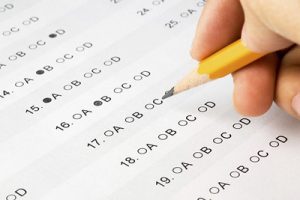
- Recitation
- Critical thinking
- Observation
- Experimentation
Pragmatism
Pragmatism is “a process philosophy that stresses evolving and change rather than being” (Johnson et. al., 2011, p. 91). In other words, pragmatists believe that reality is constantly changing so we learn best through experience.
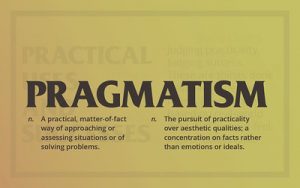
According to pragmatists, the learner is constantly conversing and being changed by the environment with whom he or she is interacting. There is “no absolute and unchanging truth, but rather, truth is what works” (Cohen, 1999, p.1). Based on what is learned at any point and time, the learner or the world in which he or she is interacting can be changed.
Key Philosophers
Peirce (1839 – 1914):
Charles Sanders Peirce is one of the first pragmatic thinkers. He introduced the pragmatic method in which students are supplied a procedure for constructing and clarifying meanings. In addition, this system helps to facilitate communication among students.
Dewey (1859 – 1952):
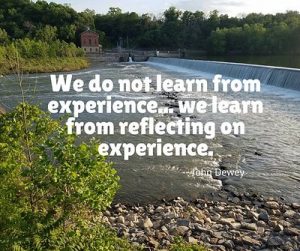 John Dewey linked pragmatism
to evolution by explaining that
“human beings are creatures who have to adapt to one another and to their environment” (Johnson et. al., 2011, p. 93). Therefore, learners within the classroom need to adapt to one another and their learning community.
John Dewey linked pragmatism
to evolution by explaining that
“human beings are creatures who have to adapt to one another and to their environment” (Johnson et. al., 2011, p. 93). Therefore, learners within the classroom need to adapt to one another and their learning community.
Dewey also believed that the application of the “scientific method” could solve an array of problems. He saw ideas as the instruments to solving problems and advocated for the application of the following steps to meet this goal:
- Recognize that the problem exists.
- Clearly define the problem.
- Suggest possible solutions.
- Consider the potential consequences of the possible solutions.
- Carry out further observation and experiment leading to the solution’s acceptance or rejection. (Anderson, 2022)
4.6 A Closer Look
- What did the “new” or “Romantic” side believe about education? What did the “old” or “traditional” side believe about education? Which side(s) did Dewey lean toward and why?
- What else did Dewey think we should take into account? Why is this so important to Dewey?
- Why did Dewey want to connect education with society?
- What is the question of education according to Dewey? Do you agree? Why or why not?
Educational Implications of Pragmatism
According to a Pragmatic school of thought, curriculum should be so planned in such a way that it teaches the learner how to think critically rather than what to think. Teaching should, therefore, be more exploratory in nature than explanatory. To promote this approach to teaching, students should be actively engaged in the learning process and be challenged to solve problems. The teachers job is to help support students learning by promoting questioning and problem-solving during the natural course of lesson delivery.
The curriculum is also interdisciplinary. Teaching methods used in pragmatism include:
- Hands-on problem solving
- Experimenting
- Projects
- Cooperative Learning
Existentialism
Existentialism is a school of philosophy that “focuses on the importance of the individual rather than on external standards” (Johnson et. al., 2011, p. 93). Existentialists believe that our reality is made up of nothing more than our lived experiences, therefore our final realities reside within each of us as individuals. As such, the physical world has no real meaning outside our human experience and there is no objective, authoritative truth about metaphysics, epistemology, and ethics.
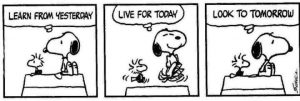
Key Philosophers
Kierkegaard (1813-1855):
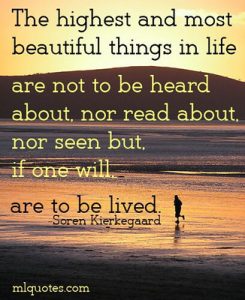
Soren Kierkegaard was a Danish minister and philosopher. He is
considered to be the founder of existentialism.
4.7 A Closer Look
Nietzsche (1844-1900):
Friedrich Nietzcshe stressed the importance of the individuality of each person. According to Johnson et. al. (2011), his work provided a “strategy to liberate people from the oppression of feeling inferior within themselves, and a teaching of how not to judge what one is in relation to what one should be” (p. 95).
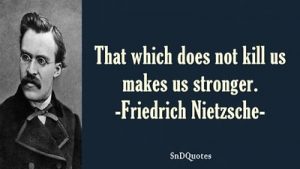
Educational Implications of Existentialism
Within an existentialist classroom, subject matter takes second place to helping the students understand and appreciate themselves for who they are as individuals. The teacher’s role is to help students accept individual responsibility for their personal thoughts, feelings, and actions. To do this, the teacher is responsible for creating an environment in which student may freely choose their own preferred way of learning by giving students latitude in their choice of subject matter.
Furthermore, answers come from within the individual in an existential classroom, not from the teacher. For this reason, Existentialists strongly oppose standardized assessments which measure or track student learning. Instead, they want the educational experience of the student to focus on creating opportunities for self-direction and self-actualization of the whole person, not just the mind (Cohen, 1999).
In an Existentialist classroom, curriculum is structured to provide students with experiences that will help unleash their own creativity and self-expression through an emphasis on teaching humanities. For example, rather than emphasizing historical events, existentialists focus upon the actions of historical individuals, each of whom provides possible models for the students’ own behavior. Math and science may be de-emphasized because their subject matter would be considered “cold,” “dry,” “objective,” and therefore less fruitful to self-awareness. In teaching art, existentialism encourages individual creativity and imagination more than copying and imitating established models.
As described above, Existentialist methods focus on the individual. Learning is self-paced, self directed, and includes a great deal of individual contact with the teacher, who relates to each student openly and honestly. Although elements of existentialism occasionally appear in public schools, this philosophy has found wider acceptance in private schools and in alternative public schools founded in the late 1960s and early 1970s.
4.8 A Closer Look
Now that you have learned about the four main schools of thought, let’s find out which one you most align to right now. In order to do this, you are going to take the quiz below. Note: Make sure to write down which school of thought you are based on your quiz results.
- What school of thought were you?
- Do you agree that you align with the school of thought identified by the quiz? Why or why not?
- What are some specific implications for you as a future teacher given the school of thought you were identified as from the quiz?
Section II: Defining your own philosophy
4.9 Essential Questions
At the end of this section, the following essential questions will be answered:
- What is a philosophy?
- What elements do you consider to be most important to include in your philosophy of education?
- Think about the elements identified in this section, do you think all of them are essential to include when writing a philosophy of education? Why or why not?

As discussed in section one, there are several key schools of thought that reflect key philosophies of education. In this section, we are going to look at the “definition” of a philosophy. We will also explore the importance of defining your own education philosophy as a future teacher. Finally, we will identify essential elements that should be considered when writing your educational philosophy.
What is a Philosophy?
When asked to think about the following question, what comes to mind: What is a Philosophy?
Common responses include:
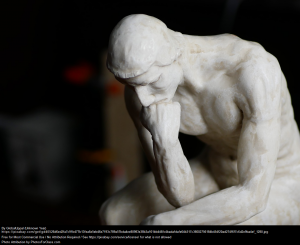
• A set of beliefs
• A personal platform
• Our personal thoughts
A philosophy is indeed all of these things, and so much more! According to the New Oxford American Dictionary (2010), a philosophy is “the study of the fundamental nature of knowledge, reality, and existence” (p. 1278).
When it comes to our educational philosophy, Webb et. al. (2010) state that our “philosophy of education enables us to recognize certain educational principles that define our views about the learner, the teacher, and the school” (p. 50). As such, it critical to determine what school of thought you most align to as this will shape the way you see the students, curriculum and educational setting.
Articulating Your Philosophy of Education
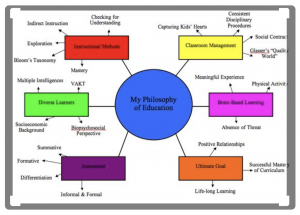
When articulating your philosophy of education, it is essential to reflect on the multiple dimension of teaching that would impact your philosophy. As demonstrated by the diagram, there are a lot of factors to consider. Take a moment to reflect on the diagram, are there any elements you feel are more important than the others? Are there elements missing that you would include? If so, what are they and why do you feel they are important?
When approaching the writing of your philosophy of education, we recommend using the following key elements to ensure that your philosophy of education is well thought out and supported, no matter which school of thought it is based upon.
- PURPOSE OF TEACHING
- Why do you teach?
- Why have you chosen to teach elementary, secondary, or a particular content area?
- What are your values as a teacher?
- FOUNDATIONS OF EDUCATION
-
- What philosophy of education do you MOST align with and why (revisit Ch. 4 – Ch. 9 of your Pressbook)?
- How has education changed historically in the
last 50/60 years (revisit Ch. 2 & Ch. 3 of
your Pressbook)? - What impact have movements like the civil rights had on schools (revisit Ch. 2 of your Pressbook)?
-
- How have educational policies like NCLB and the standardized testing movement impacted educators and instructional decisions/programming?
- In what ways has the increased diversity in our educational settings impacted the need for teachers to be prepared to address the needs of linguistically and culturally diverse students in their classrooms now more than ever before?
3. UNDERSTANDING OF TEACHING AND LEARNING
-
- What approaches, methods, pedagogy do you use and why and how are these influenced by the philosophy you MOST aligned with (revisit Ch. 4 – Ch. 9 of your Pressbook)?
- Which elements of effective instruction do you think are most important to apply to support ALL students learning?
- What strategies do you apply to actively engage ALL your students throughout the lesson?
- How do you motivate your students to learn?
- How do you motivate yourself to be the teacher your students need you to be?
4. CLASSROOM ENVIRONMENT
-
- How do you create a community of learners (revisit Ch. 1 of your Pressbook)?
- What is your “code of conduct” (revisit Ch. 1 of your Pressbook)?
- How do you engage students to limit disruptions and time off task?
- If disruptions do occur, what do you do?
5. INCLUSIVENESS
-
- Do you understand your own bias and how this
impacts your teaching (revisit Ch. 2 of
your Pressbook)? - How are you effective with ALL students (revisit Ch. 2 of your Pressbook)?
- How do you create a culturally responsive class room environment (revisit Ch. 1 of your Pressbook)?
- How do you teach UNCONDITIONALLY so that all your students get the best education possible and you demonstrate respect for the customs and beliefs of the diverse student groups represented in your classroom?
- What specific strategies do you use to support diverse learners?
- In what ways do you act as an advocate for your
students, their families, and the
community?
- Do you understand your own bias and how this
impacts your teaching (revisit Ch. 2 of
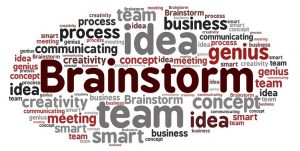
Take a moment to reflect on all the information
you read about educational philosophies.
Your challenge is to write at least a one-page,
single-spaced philosophy of education paper
that summarizes your current philosophy of
education.
Section III: The importance of student voices
4.10 Essential Questions
By the end of this section, the following essential questions will be answered.
- What can we learn from student voices?
- What insights might you gain from the student quotes?
- What did you learn from watching the video clips?
- What links did you make between the what the speakers shared in the video clips and the different schools of thought discussed in this chapter?
To best understand the power of an educational philosophy in practice, this section is going to provide you with two different sets of evidence. The first set of evidence comes from KSU students. The second set comes from a student and two educators in the field. As you read and listen to the information being shared, please reflect on the questions to consider. Although you do not need to document your responses to each of the questions, they have been provided to help you critical reflect on the information being presented.
4.11 Student Voices
- “My philosophical belief is that I want to prepare my children, not for the next grade or college; but for their future in society through tools learned in the classroom.” ASU16
- “I feel that after studying several popular philosophies of education my personal philosophy is a medley of all of them, making it completely mine.” DP U16
- “Every experience I have impacts the way I look at the world and I will continue to strive to keep my teaching the same while as the same time adapting to the needs of my students.” MLU16
4.12 A Closer Look
The following video provides and more in-depth look the importance of having a solid philosophy of education from a student’s point of view. As you watch this video, consider the following questions:
- What insights did you gain from the video?
- Based on the information shared, what school of thought(s) do you think influenced prior educational experiences of this student?
- What school of thought do you think this student is advocating for in the future? Why?
As demonstrated in the student voices, and video by Adora Avitak, being able to articulate your philosophy of education is essential as a future educator. For your philosophy of education shapes your delivery of academic content, but more importantly guides your beliefs when it comes to working with students. To learn more about the importance of how educators view students, let’s watch Rita Pierson.
4.7 A Closer Look
As you listen to Rita Pierson, consider the following questions:
- What insights did you gain from the video?
- Based on the information shared, what school of thought(s) do you think influence this teacher?
- How might you apply what you learned from Rita Pierson to your own future practice?
Rita Pierson is such a powerful educator and advocate for students. I hope you learned a lot from her TedTalk! As we wrap up this chapter, I leave you with one final question: How will you be a champion for your future students?!
References
Anderson, A. M. (2022). Reflecting on Refugee Simulations as Experiential Learning Opportunities to Improve Empathy and Cross-Cultural Communication. Journal of Scholarly Engagement, 5(1), 18-26. https://www.researchgate.net/publication/361647730_Reflecting_on_Refugee_Simulations_as_Experiential_Learning_Opportunities_to_Improve_Empathy_and_Cross-Cultural_Communication
Cohen, S. M. (1999). In Gail Fine, Plato I: Metaphysics and Epistemology. Oxford University Press.
Johnson, J. A., , Musial, D, Hall, G. E., and Gollnick, D. M. (2011). Foundations of American Education: Perspectives on Education in a Changing World (15th Edition). Pearson.
Paul, R. W. (n/d). Six Types of Socratic Questions. Trigon. https://www.trigonweb.com/dowload/SOCRATIC%20QUESTIONS.pdf
Stevenson, A. & Lindberg, C. A. (Ed.) (2010). New Oxford American Dictionary. Oxford University Press.
Webb, L. D., Metha, A., & Jordan, K. F. (2010). Foundations of American Education. Pearson Merrill.
Media Attributions
- Socrates Aristotle Shakespeare Flintstone © esmemes
- Plato Quote © TraumaAndDissociation
- Socrates Quote © obscuredreamer
- Kant Quote © Butrous Foundation
- Socratic Circle © Samantha Bush
- Aristotle Quote © Mountaingoat Seventeen
- Standardized Test © Alberto G.
- Pragmatism Pic © Kristian Bjornard
- Dewey Quote © PetiteFamily93
- Existentialist Snoopy © Rob S
- Kierkegaard Quote © Max Lagace
- Nietzcshe Quote © SnD Quotes
- Glass half full © Geralt
- Thinking © GlobalUppal
- My Philosophy of Education © Kelsey F. Hawkins
- Brainstorm

